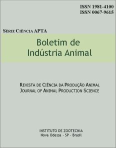Forage plants competition in São Paulo State V. São José do Rio Preto
Abstract
In a field experiment at the Estação Experimental de Zootecnia de São José do Rio Preto, in State of São Paulo, Brazil, was studied, during two years, the adaptation of six grasses and six forage legumes, with and without fertilization. The grasses tested were: Panicum maximum, Jacq., Panicum maximum. Jacq. var. Trichoglume cv. Petrie (green panic), Panicum maximum Jacq. cv. Gatton panic, Setaria anceps Stapf. ex Massey cv. Kazungula, Brachiaria decumbens Stapf. cv. Australiano and Hyparrhenia rufa (Ness) Stapf. The legumes were: Macroptilium atropurpureum DC cv. Siratro, Centrose. me pubescens Benth, Sty/osanthes hamata (L.) Taub. cv. Verano, Calopogonium mucunoides Desv. Glycine wightü Verdc. and Desmodium subsericeum Malme. The results of dry matter yield and protein yield two years of evaluation showed that Pari icum meximum Jacq., Brachiaria decumbens Stapf. cv. Australiano,Macroptilium atropurpureum DC cv. Siratro, Stylosanthes hamata (L.) Taub. cv. Verano and Centrosema pubescens Benth. outstood. The significant effects of fertilization were observed in every forages studied, with especially to gatton panic and perennial soybean.Downloads
Downloads
Published
Issue
Section
License
Os autores não serão remunerados pela publicação de trabalhos, pois devem abrir mão de seus direitos autorais em favor deste periódico. Por outro lado, os autores ficam autorizados a publicar seus artigos, simultaneamente, em repositórios da instituição de sua origem, desde que citada a fonte da publicação original seja Boletim de Indústria Animal. A revista se reserva o direito de efetuar, nos originais, alterações de ordem normativa, ortográfica e gramatical, com vistas a manter o padrão culto da língua e a credibilidade do veículo. Respeitará, no entanto, o estilo de escrever dos autores. Alterações, correções ou sugestões de ordem conceitual serão encaminhadas aos autores, quando necessário. Nesses casos, os artigos, depois de adequados, deverão ser submetidos a nova apreciação. As opiniões emitidas pelos autores dos artigos são de sua exclusiva responsabilidade. Todo o conteúdo deste periódico, exceto onde está identificado, está licenciado sob a Licença Creative Commons Attribution (CC-BY-NC). A condição BY implica que os licenciados podem copiar, distribuir, exibir e executar a obra e fazer trabalhos derivados com base em que só se dão o autor ou licenciante os créditos na forma especificada por estes. A cláusula NC significa que os licenciados podem copiar, distribuir, exibir e executar a obra e fazer trabalhos derivados com base apenas para fins não comerciais.













